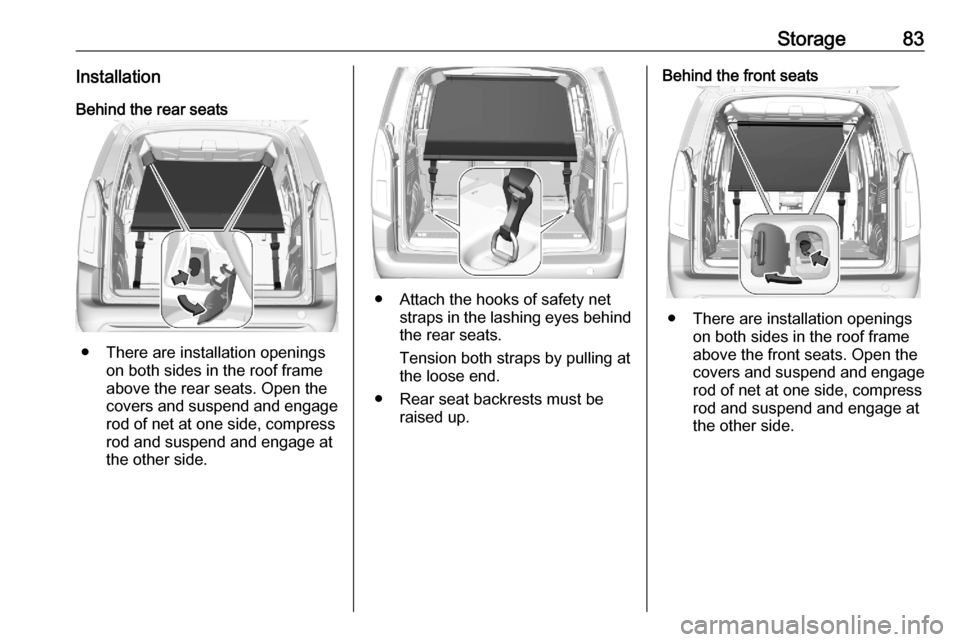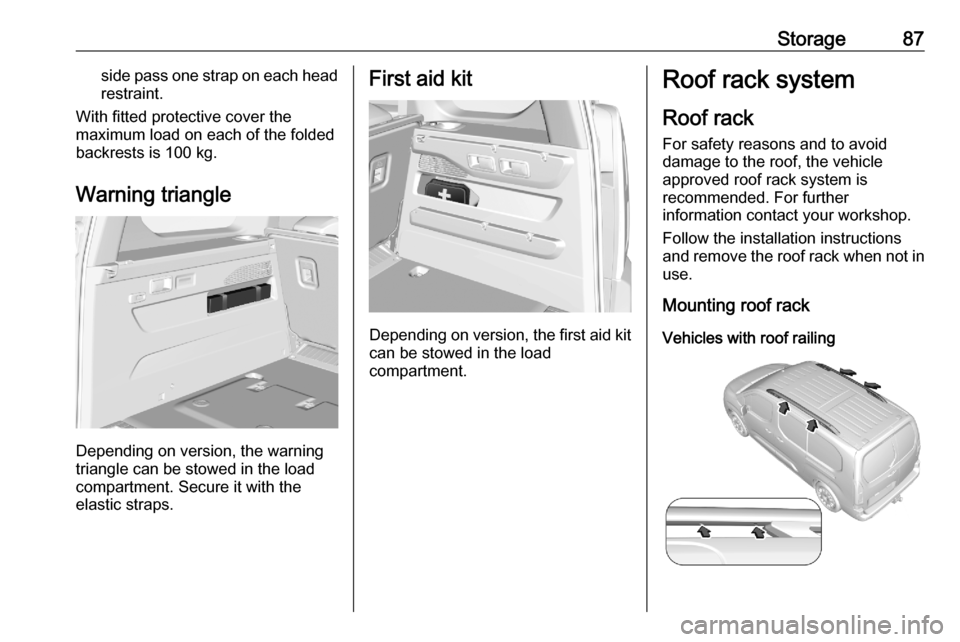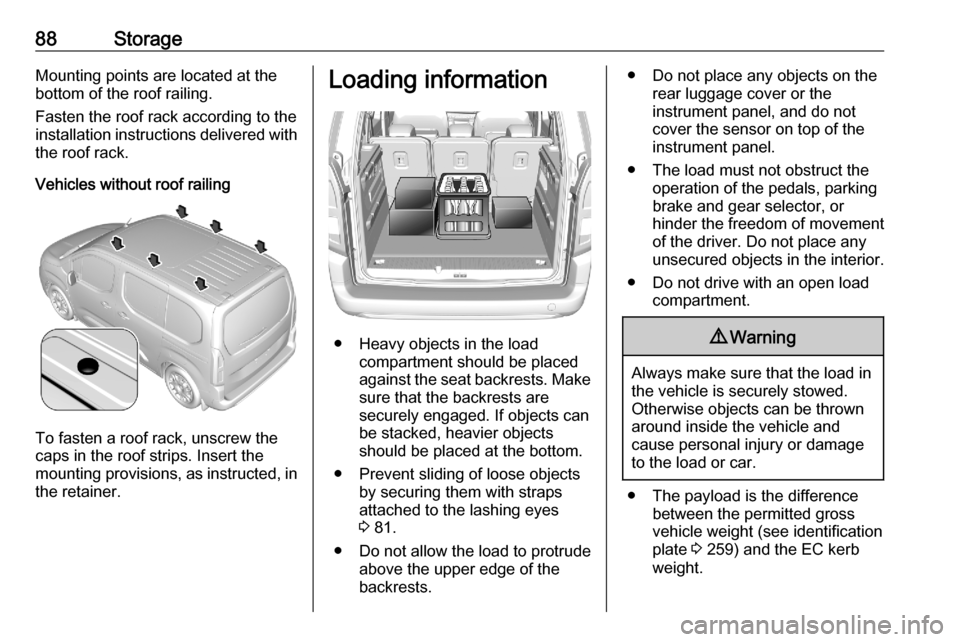OPEL COMBO E 2020 Manual user
Manufacturer: OPEL, Model Year: 2020, Model line: COMBO E, Model: OPEL COMBO E 2020Pages: 283, PDF Size: 29.4 MB
Page 81 of 283

Storage79Opening the cover
Remove load compartment cover
from side brackets. Guide the cover
until it is fully rolled up.
Removing the cover
Open the load compartment cover.
Compress the load compartment
cover at one side and lift it up.
Remove the load compartment cover.
Stowing in the load compartment
If the load compartment cover is not
used, stow it in the load compartment. It can be stowed behind the second or
third row seats.
Fitting the cover
Insert the load compartment cover
into the recess at one side. Compress the cover at the other side and
engage it in the recess.
Page 82 of 283

80StorageRear parcel shelf
Do not place any excessively heavy
or sharp-edged objects on the rear
parcel shelf. The maximum load
permissible is 25 kg. With high loads install the safety net behind the rear
seats 3 82.
Installing the rear parcel shelf
The rear parcel shelf can be installed
in two positions.
Fit the parcel shelf by engaging in the retainers on both sides.
Lifting the rear parcel shelf
The rear parcel shelf may be folded
up from the rear, allowing greater
flexibility in the load compartment.
Stowing in the load compartment
Set up the folded cover upright behind the rear seat backrests.
Page 83 of 283

Storage81Lashing eyes
The lashing eyes are designed to
secure items against slippage, e.g.
using lashing straps or luggage net.
Lashing eyes may be located on the
vehicle floor and / or in the sidewall.
The number and location of the
lashing eyes may vary depending on
the vehicle.
The maximum force applied to the
lashing eyes should not exceed
500 daN / 5 kN / 5000 N.
Depending on country, the maximum
force may be shown on a label.
Note
Specifications on the label always
have priority over those given in this manual.
Cargo management system
Depending on version, a partition
behind the front seats protects the
driver and front passengers against
the risk of load movement.
There may be a flap in the partition
behind the passenger seat which can
be removed to accommodate long
objects. A protective cover is
provided in the vehicle to assure safe transportation.
If the outer passenger seat backrest
is folded down and the partition flap is open, the centre seat has to stay free.
Removing the flap
1. Release the locking device, lower
the flap and then remove it.
2. Stow the flap behind the driver’s seat.
Page 84 of 283

82Storage
Turn the locking device upwards.
Put the hinges of the flap in their
housing, lift the flap and close the
locking device.
Fitting the protective cover
The protective cover must be
installed whenever the outer
passenger seat backrest is folded
down and the partition flap is open.
1. Fold the outer passenger seat backrest 3 50.2. Attach the four snap hooks of the
cover on the corresponding
lashing eye.
3. Pull the head restraint from the folded backrest, leaving two
notches visible on the head
restraint rod 3 47.
4. Load the objects.5. Pass the strap of the cover around
the head restraint. Tension the
strap by pulling at the loose end.
With fitted protective cover the
maximum load on the folded backrest is 100 kg.
Safety net
Depending on version, the safety net
can be installed behind the rear seats
or, if the rear seat backrests are
folded, behind the front seats.
Passengers must not be transported
behind the safety net.
Page 85 of 283

Storage83InstallationBehind the rear seats
● There are installation openings on both sides in the roof frame
above the rear seats. Open the covers and suspend and engage
rod of net at one side, compress
rod and suspend and engage at
the other side.
● Attach the hooks of safety net straps in the lashing eyes behindthe rear seats.
Tension both straps by pulling at
the loose end.
● Rear seat backrests must be raised up.
Behind the front seats
● There are installation openings on both sides in the roof frame
above the front seats. Open the
covers and suspend and engage
rod of net at one side, compress
rod and suspend and engage at
the other side.
Page 86 of 283

84Storage
● Wind one strap around the barlocated under the front driver
seat cushion. The other one wind
around the bar of the passenger
seat. Then secure each hook to
the corresponding strap.
Tension both straps by pulling at
the loose end.
● Push down head restraints and fold down rear seat backrests
3 77.
Load compartment grille
Depending on version a partition
protects the driver and passengers
against the risk of load movement.
The partition can be placed behind
the front or rear seats.
There is a flap in the partition which
can be opened to accommodate long
objects. A protective cover is
provided in the vehicle to assure safe transportation.
If the side seat backrest is folded
down and the partition flap is open the centre seat has to stay free.
If the backrest of the rear seat is
lowered and the flap open to transport
long objects, the front passenger seat
has to stay free.
Page 87 of 283

Storage85Moving the partition
1. Release the four locking deviceson the top and the bottom of the
partition.
2. To be placed behind the front seats fold down the rear seat
backrests 3 53
3. Move the partition and lock the
four locking devices on the top
and the bottom.
9 Warning
Take care when operating the
bottom locking devices. Risk of
pinching.
Opening the flap
1. Depending on the positioning of the partition and the length of the
load fold down the outer rear seat
backrest and / or passenger seat
backrest 3 50, 53
2. Release the locking device of the
flap and open the flap.
3. Secure the flap with the rod.
Page 88 of 283

86StorageClosing the flap1. Fix the rod in the bracket.
2. Close the flap and lock the locking
device.
3. Restore the seats to the upright position 3 50, 53
Fitting the protective cover
The protective cover must be
installed whenever the side seat
backrest is folded down and the
partition flap is open.
1. Attach the four snap hooks of the cover on the corresponding
lashing eye.
2. Pull the head restraint from the folded backrest, leaving two
notches visible on the head
restraint rod 3 47.
3. Load the objects.4. Pass the strap of the cover around
the head restraint. Tension the
strap by pulling at the loose end.
If the loading is stored on the front
and rear seat at the passenger
Page 89 of 283

Storage87side pass one strap on each headrestraint.
With fitted protective cover the
maximum load on each of the folded
backrests is 100 kg.
Warning triangle
Depending on version, the warning
triangle can be stowed in the load
compartment. Secure it with the
elastic straps.
First aid kit
Depending on version, the first aid kit can be stowed in the load
compartment.
Roof rack system
Roof rack
For safety reasons and to avoid
damage to the roof, the vehicle
approved roof rack system is
recommended. For further
information contact your workshop.
Follow the installation instructions
and remove the roof rack when not in use.
Mounting roof rack
Vehicles with roof railing
Page 90 of 283

88StorageMounting points are located at the
bottom of the roof railing.
Fasten the roof rack according to the
installation instructions delivered with
the roof rack.
Vehicles without roof railing
To fasten a roof rack, unscrew the
caps in the roof strips. Insert the
mounting provisions, as instructed, in the retainer.
Loading information
● Heavy objects in the load compartment should be placed
against the seat backrests. Make
sure that the backrests are
securely engaged. If objects can
be stacked, heavier objects
should be placed at the bottom.
● Prevent sliding of loose objects by securing them with straps
attached to the lashing eyes
3 81.
● Do not allow the load to protrude above the upper edge of the
backrests.
● Do not place any objects on the rear luggage cover or the
instrument panel, and do not cover the sensor on top of theinstrument panel.
● The load must not obstruct the operation of the pedals, parking
brake and gear selector, or
hinder the freedom of movement
of the driver. Do not place any
unsecured objects in the interior.
● Do not drive with an open load compartment.9Warning
Always make sure that the load in
the vehicle is securely stowed.
Otherwise objects can be thrown
around inside the vehicle and
cause personal injury or damage
to the load or car.
● The payload is the difference between the permitted gross
vehicle weight (see identification
plate 3 259) and the EC kerb
weight.